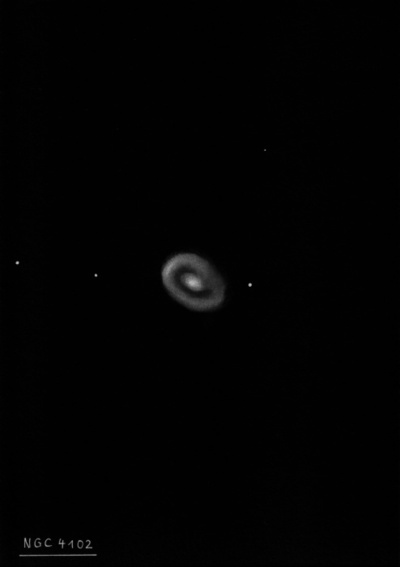
William Herschel discovered NGC 4102 = H I-225 = h1085 on 12 Apr 1789 (sweep 919) and noted "pB, pL." JH recorded "B; R; psbM; has a * 12m 35" sp, very near the edge." and measured an accurate position.
Bindon Stoney, Lord Rosse's assistant, noted on 13 Apr 1852, "I suspect a dark curved passage south of center, probably a new spiral." Four years later R.J. Mitchell confirmed "I have little doubt this is a spiral" and he made two diagrams of the arm arrangement.
400/500mm - 17.5" (5/13/88): fairly bright, moderately large, oval 3:2 SW-NE, small very bright core, stellar nucleus. A mag 12.5 star is at the west end 48" from the center!
900/1200mm - 48" (4/20/17): at 488x; fascinating galaxy with unusual structure. Overall, NGC 4102 is very bright, large, elongated at least 2:1 SSW-NNE, ~2.5'x1.1', very sharply concentrated with a small, intensely bright nucleus surrounded by a bright oval core SW-NE with a bar-like enhancement. Just outside the core the surface brightness drops significantly forming a darker [dusty] annulus. Surrounding this is a bright, thick, mottled ring oriented NNW-SSE (slightly offset in orientation from the core). A brighter knot (SDSS J120625.26+524307.4) is at the NE end of the ring [32" NE of center]. On the SDSS this corresponds with the brightest star cloud in the galaxy and the site of supernova 1975E. A brighter mag 12.5 star is 50" WSW of center, just outside the halo. When the seeing settled this star resolved into a close pair (~13.2/13.8 at 1.8" separation!) NGC 4068 lies 23' WSW. Member of the M109 (NGC 3992) group = LGG 258.
Notes by Steve Gottlieb